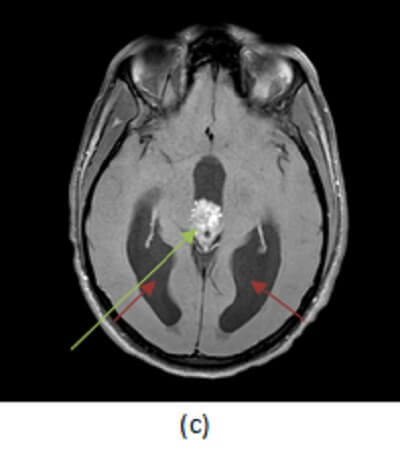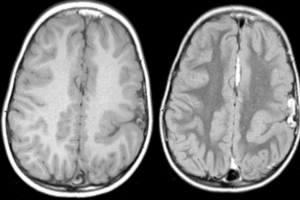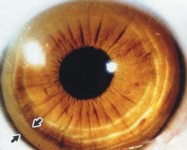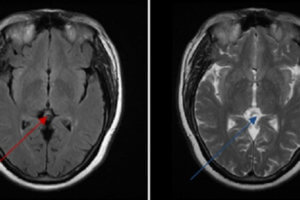
Tumors of the pineal gland can be categorized into pineal cell and germ cell depending of their cell type of origin. Germ cell tumors (GCT’s) are more common than pineal cell tumors. The two most GCT’s are germinoma and teratoma. .
Diagnosis: Germinoma


Figure 1: Pineal mass with heterogenous T1 (a, red arrow) and T2 (b, blue arrow) signal . The mass also heterogeneously enhances on post contrast T1 sequences (c, green arrow) and is associated with hydrocephalus (purple arrow).
Unlike pineal cell tumors, germinomas tend to “engulf” pineal calcifications, displacing them inwards. They are also typically associated with elevated serum markers. Germinoma’s account for about 60% of GCT’s, are associated with elevations in BHCG and occur disproportionately in young men. Situated in the midline around the third ventricle, they may involve sites other than the pineal gland, including the parasellar region and the basal ganglia. In fact, simultaneous pineal and suprasellar teratomas occur in 20% of cases. Germinomas have intense, uniform enhancement and may disseminate throughout the CSF. As a result, complete imaging of the brain and spine should be performed prior to treatment to evaluate the extent of disease. The presence of intra-tumoral cysts correlates with a worse prognosis. Treatment includes radiation and chemotherapy.
Teratomas are the second most common GCT. Like germinomas, they occur disproportionately in young men, are situated at the midline around the 3rd ventricle and may seed the entire neuraxis. However, teratomas often contain fat – seen as T1 hyperintensity or loss of signal within the mass on fat saturated sequences like (STIR = Short Tau Inversion Recovery). Treatment also begins with resection, followed by chemotherapy and radiation.
Masses in the pineal region can compress the third ventricle leading to hydrocephalus or compress the dorsal midbrain inferiorly resulting in paralysis of upward gaze and nystagmus from compression of the superior colliculus and oculomotor nucleus (Perinaud’s syndrome).



